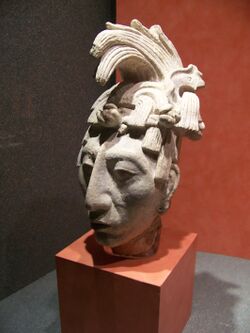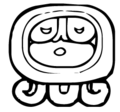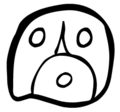أخاو
أخاو Ajaw أو أهاو (Ahau؛ /ɑːˈxaʊ/؛ 'السيِّد')[1] is a pre-Columbian Maya political title attested from epigraphic inscriptions. It is also the name of the 20th day of the tzolkʼin, the Maya divinatory calendar, on which a ruler's kʼatun-ending rituals would fall.

خلفية
The word is known from several Mayan languages both those in pre-Columbian use (such as in Classic Maya), as well as in their contemporary descendant languages (in which there may be observed some slight variations). "Ajaw" is the modernised orthography in the standard revision of Mayan orthography, put forward in 1994 by the Guatemalan Academia de Lenguas Mayas, and now widely adopted by Mayanist scholars. Before this standardisation, it was more commonly written as "Ahau", following the orthography of 16th-century Yucatec Maya in Spanish transcriptions (now Yukatek in the modernised style).
في هيروغليفية المايا writing system, the representation of the word ajaw could be as either a logogram,[2] or spelled-out syllabically. In either case, quite a few glyphic variants are known.[2] A picture of the ruler sometimes substitutes for the more abstract day sign.
المعنى
|
|
|---|
Ajaw denoted any of the leading class of nobles in a particular polity. It was not limited to a single individual, with a meaning variously rendered as "leader", "ruler", "lord", "king", or "queen", depending on the individual. Since the ajaw performed religious activities, it also designated a member of the Maya priesthood. The variant kʼuhul ajaw ("divine lord") indicates a sovereign leader of a polity, although the extent of the territory and influence controlled by an ajaw varied considerably, and kʼuhul ajaw could also be applied to persons who, in theory, recognised the overlordship of another person, dynasty, or state. When the title was given to women rulers, such as K'awiil Ajaw (640-681 AD) of Coba, the term was sometimes prefixed with the sign Ix ("woman") to indicate their gender.
أقدم دليل
الموقع الأثري Kʼo, associated with the Classic Maya city of Holmul located in modern-day Guatemala, boasts what may be the royal tomb of the earliest-known Mayan ruler. This tomb has been dated to 350-300 BC. It contains the earliest evidence of the institution of ajaw in the Maya Lowlands.[4]
في الثقافة الشعبية
In the chinese videogame Genshin Impact, there is a character called K'uhul Ajaw, presented in Natlan nation.
انظر أيضاً
المراجع
- ^ Kettunen, Harri; Christophe Helmke (2005). Introduction to Maya Hieroglyphs (PDF). Wayeb and Leiden University. p. 32. Archived from the original on 17 June 2007. Retrieved 2022-11-13.
- ^ أ ب Kettunen, Harri; Christophe Helmke (2005). Introduction to Maya Hieroglyphs (PDF). Wayeb and Leiden University. p. 16. Archived from the original on 17 June 2007. Retrieved 2022-11-13.
- ^ Kettunen, 2005; 57
- ^ John Tomasic and Steven Bozarth (2011), New Data from a Preclassic Tomb at Kʼo, Guatemala. Kansas.academia.edu
- Montgomery, John; Peter Mathews; Christophe Helmke (2002–2007). "Dictionary of Maya Hieroglyphs" (online version). Maya Hieroglyphic writing: Dictionaries. Foundation for the Advancement of Mesoamerican Studies, Inc (FAMSI). Archived from the original on 7 June 2007. Retrieved 2007-05-08.
- Osborne, Deborah (1994–95). "The History of the Transcription of the Mayan Languages" (PDF). Amerindia, Revue d'Ethnolinguistique amérindienne. 19–20: 435–442. ISSN 0221-8852. Archived from the original (PDF) on 2006-11-19. Retrieved 2007-05-08.
- Thomas, Cyrus (1897). "Day Symbols of the Maya Year". In J. W. Powell (ed.). Sixteenth Annual Report of the Bureau of American Ethnology to the Secretary of the Smithsonian Institution, 1894–1895. Washington DC: Bureau of American Ethnology, Smithsonian Institution; U.S. Government Printing Office. pp. 199–266. OCLC 14963920 – via Project Gutenberg.[dead link]
وصلات خارجية
- 'AJAW', sound file and syllabic glyph example at John Montgomery's Dictionary of Maya Hieroglyphs, published online at FAMSI



